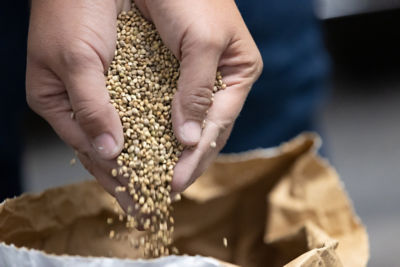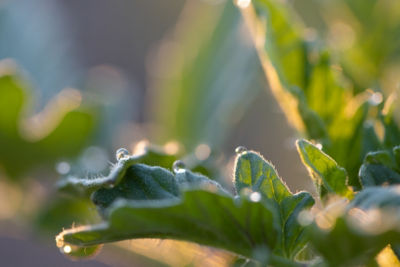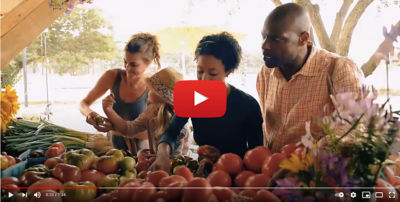» Diseases and insect pests of pepper may require the use of in-season control measures.
» Cultural practices and chemical treatments can help manage disease and insect problems during the season.
» Regular field scouting is needed for adequate management of some diseases and insect pests.
This article will use example disease and insect pests to describe management practices that can be implemented during the season to protect yield and fruit quality. This article will not cover management strategies that would be initiated at or before planting such as crop rotation or use of host resistant varieties.
ANTHRACNOSE
Anthracnose can affect all above-ground parts of the plant. Infections of the fruit are the most economically important, and fruit become more susceptible to infection as they mature and ripen.1
The fungi that cause anthracnose on peppers can infect a large number of hosts. Therefore, managing weed species that can serve as sources of the disease is important.2 Because the spores of the fungus are disseminated by splashing water, avoiding overhead irrigation can help slow the spread of the disease. Managing insects that wound the fruit can also reduce the chances of infection.
The application of foliar fungicides (Table 1) can provide some control of the disease if inoculum levels in the field are low or when conditions are not optimal for infection and disease development. Copper-based fungicides provide limited protection from anthracnose, but they can be used in certain circumstances in organic production systems.1 Fungicide applications should begin when the first fruit begin to mature and continue to be applied as directed by the label instructions, usually on a seven to ten day interval.3
SOUTHERN BLIGHT
Southern blight (also called basal stem rot) is a destructive disease that occurs in warm, humid regions of the U. S. where daily winter temperatures rarely drop below freezing. The fungal pathogen has a wide host range of over 500 plant species. On peppers, the pathogen causes damping-off of seedlings and stem rots of older plants.1
In-season management options for southern blight include rouging-out (removing) infected plants (when this is economically feasible), controlling weeds that can serve as hosts for the pathogen, and avoiding injuries to the plants during cultivation that can increase the rates of infection. Because the disease is favored by low soil pH levels, in- season fertilization with ammonia based fertilizers can result in lower rates of southern blight than are seen when nitrate fertilizers are used.1
In fields that have been strip-fumigated, avoid overhead irrigation that can splash pathogen-infested soil from between the beds onto the plants. The application of fungicides can provide some control or suppression of southern blight (Table 1), and several biological control agents, including species of Trichoderma, Gleocladium virens, and Bacillus subtilis are commercially available to help reduce the damage caused by southern blight.1
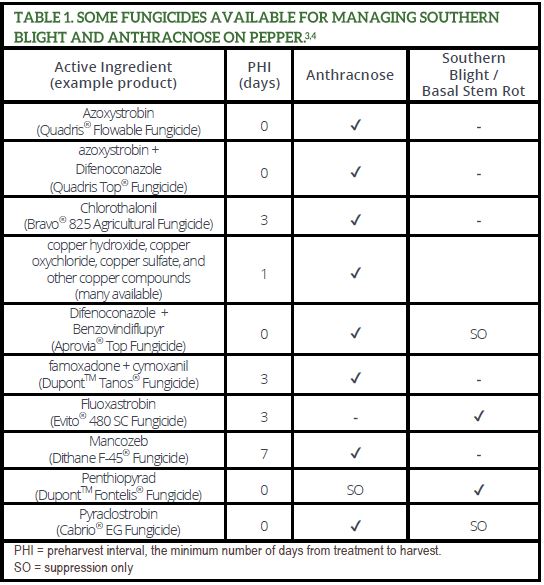
THRIPS
Several species of thrips can occur on peppers, but not all species cause problems. In fact, native species of thrips can out compete pest species and prevent damage. The western flower thrips (WFT) is the species that causes the most problems on peppers grown in the U.S. The primary damage associated with WFT feeding results from the transmission of the Tomato spotted wilt virus (TSWV), as WFT is the major thrips vector for this virus.5,6 Feeding of large populations of WFT can cause direct damage including distortions and silvering of leaves and fruit.
The population levels of various thrips species can be monitored using yellow sticky traps and through scouting and inspection of plants. When scouting, collect ten flowers from each of several randomly selected location in the field, and examine small, medium, and large sized fruit by looking for insects under the calyx. Count the number of larvae per fruit. Six WFT per flower or two per fruit is tolerable, counts above that may indicate the need for treatment. Do not treat for eastern flower thrips or other non-pest species.5
When treating for thrips, the primary goal is to prevent damage, not to kill the insects. Using reduced risk insecticides, such as spinosad and spinetoram, in combination with natural and released predators can provide effective control.5 If multiple applications are required, rotating classes of insecticides (Table 2) can help prevent or delay the development of insecticide resistance in thrips populations. Some of the insecticides used to manage thrips are harmful to bees and other pollinators. Special precautions may be needed to protect these beneficial insects from exposure.6 Always consult the most up-to-date product label for directions and restrictions. Some products may not be registered for use in all states.
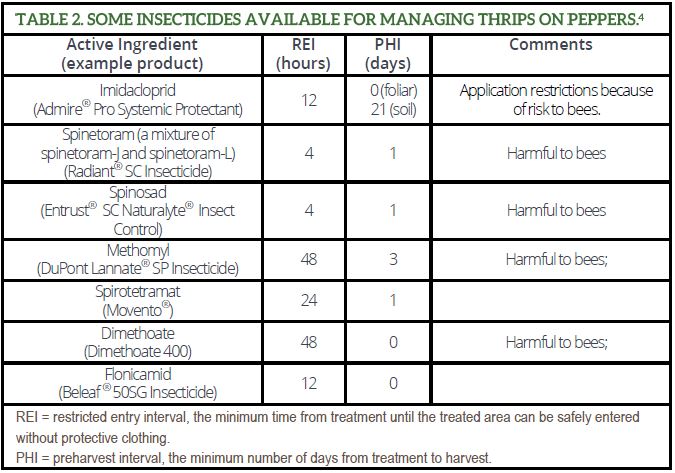
PEPPER WEEVIL
Adult pepper weevil feed on fruit and leaf buds causing damage, while weevil larvae feed inside of the pods. Larval feeding can cause young fruit to drop prematurely, and the presence of larvae reduces the marketability of larger fruit.
Management efforts should include removing culled and dropped fruit from the field to reduce sources of infestation. To determine if treatments are needed, use pheromone baited sticky traps or examine terminal buds to monitor weevil populations. Check traps or scout twice a week, and treat when the first adult is detected.7 Insecticides can be used to treat weevil infested fields (Table 3), but measures should be taken to protect bees and other beneficial insects.
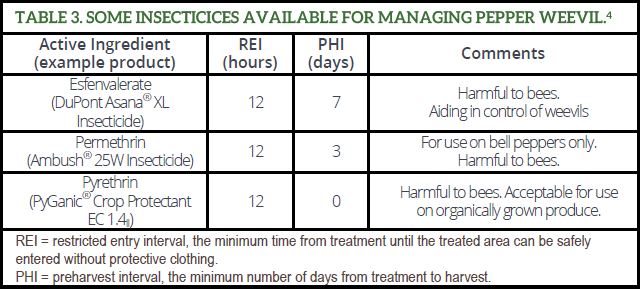
SOURCES
1 Pernezny, K., Roberts, P., Murphy, J., and Goldberg, N. 2003. Compendium of pepper diseases. American Phytopathological Society.
2 Koike, S., Davis, R., and Subbarao, K. 2016. Peppers: Powdery mildew. UC IPM, UC Pest Management Guidelines. UC ANR Publication 3460.
3 Reiners, S., Bellinder, R., Curtis, P., Helms, M., Landers, A., McGrath, M., Nault, B., and Seaman, A. 2017. Cornell integrated crop and pest management guidelines for commercial vegetable production.
4 Vegetable Production Handbook of Florida 2015-2016. UF-IFSA
5 Funderburk, J., Reitz, S., Stansly, P., Freeman, J., Miller, C., McAvoy, G., Whidden, A., Demirozer, O., Nuessly, G., and Leppla, N. 2015. Managing thrips in pepper and eggplant. University of Florida IFAS, ENY-658.
6 Natwick, E., Trumble, J., and Aguiar, J. 2016. Thrips. UC Pest Management Guidelines: Peppers, UC ANR Publication 3460.
7 Natwick, E., Trumble, J., and Aguiar, J. 2016. Pepper weevil. UC Pest Management Guidelines: Peppers, UC ANR Publication 3460.
ADDITIONAL INFORMATION
For additional agronomic information, please contact your local seed representative. Developed in partnership with Technology, Development & Agronomy by Monsanto.
Individual results may vary, and performance may vary from location to location and from year to year. This result may not be an indicator of results you may obtain as local growing, soil and weather conditions may vary. Growers should evaluate data from multiple locations and years whenever possible. ALWAYS READ AND FOLLOW PESTICIDE LABEL DIRECTIONS. The recommendations in this article are based upon information obtained from the cited sources and should be used as a quick reference for information about pepper pest management. The content of this article should not be substituted for the professional opinion of a producer, grower, agronomist, pathologist and similar professional dealing with this specific crop.
SEMINIS DOES NOT WARRANT THE ACCURACY OF ANY INFORMATION OR TECHNICAL ADVICE PROVIDED HEREIN AND DISCLAIMS ALL LIABILITY FOR ANY CLAIM INVOLVING SUCH INFORMATION OR ADVICE. 170826144356 101817DME
Seminis® is a registered trademark of Seminis Vegetable Seeds, Inc. © 2016 Seminis Vegetable Seeds, Inc.
